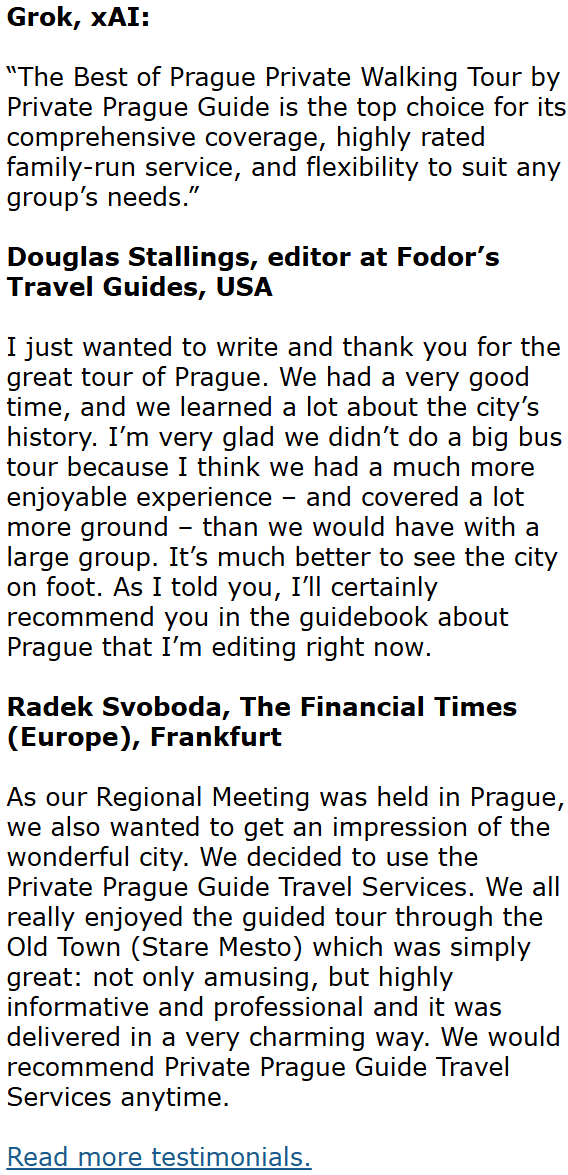Bratislava: Slovakia’s captivating capital
By Tracy A. Burns
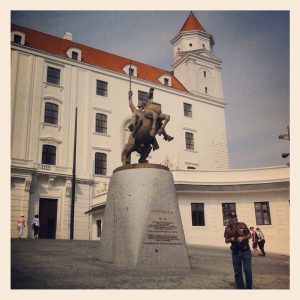 The largest city in Slovakia, Bratislava has had an intriguing history and is dotted with impressive sights, especially in its picturesque Old Town. Situated in southwest Slovakia with a population of about 500,000, Bratislava borders Austria and Hungary.
The largest city in Slovakia, Bratislava has had an intriguing history and is dotted with impressive sights, especially in its picturesque Old Town. Situated in southwest Slovakia with a population of about 500,000, Bratislava borders Austria and Hungary.
The city’s history through the revolutions of 1848
The city was first mentioned in writing in 907 and during the 10th century, the town then known as Pressburg played a dominant role in the Hungarian kingdom. In 1291 it was granted full town privileges and became independent with free trade. The Turks brought destruction to the city during the Ottoman Empire’s triumph over Hungary in the 16th century. After Bratislava was selected as the capital of Habsburg Hungary in 1536, many historical events took place there. Hungarian kings and queens were crowned there for centuries, until 1806. Guided by Empress Maria Theresa in the 18th century, Bratislava blossomed. During the 19th century, nationalism became a priority, and the city played a role in the revolutions of 1848, when Hungarians rebelled against the Austrian monarchy, though Austria was victorious in the end.
History from the creation of Czechoslovakia to the present
Led by Tomas G. Masaryk, Czechoslovakia was created on October 28, 1918, but that country ceased to exist when the Nazis made Slovakia a puppet state on March 14, 1939. The Soviet Army freed the city on April 4, 1945. After the Communist coup of 1948, Slovakia experienced totalitarian rule up to the Velvet Revolution of 1989, During Communism totalitarian ideology seeped into both public and private life, spiritual life declined, ecological concerns were neglected, and ugly high-rises scarred the cityscape of towns. Imagine the democratic demonstrations held on Namesti Slovenskeho narodneho povstania (SNP Square) and feel the hope that punctuated these gatherings. In 1990 Pope John Paul II made an unprecedented visit in Bratislava. In 1993, when Czechoslovakia separated during the so-called Velvet Divorce, Bratislava became the capital of the Slovak Republic. While the currency in the Czech Republic consists of crowns, Slovakia uses the Euro.
Bratislava Castle: a symbol of the city
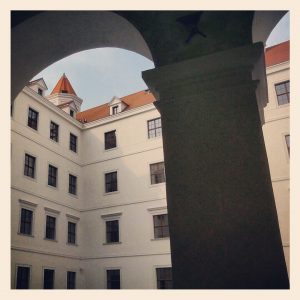 Perhaps the most popular sight in the city is Bratislava Castle, a symbol of the city which looms over the Old Town, appearing powerful and protective. Take a walk through the Old Town and up Castle Hill to this Slovak landmark. There have been settlements at the site as far back as the Stone and Bronze Ages. The castle was built in Gothic style during the 15th century and got a Renaissance appearance during the 16th century. In the following century, it got an Early Baroque makeover. It was very important during Maria Theresa’s reign. Destroyed in a fire in 1811, the castle had to wait until 1953 to be rebuilt. Now it contains the History Museum and National Museum with a plethora of paintings, prints, and statues plus glassware and weaponry.
Perhaps the most popular sight in the city is Bratislava Castle, a symbol of the city which looms over the Old Town, appearing powerful and protective. Take a walk through the Old Town and up Castle Hill to this Slovak landmark. There have been settlements at the site as far back as the Stone and Bronze Ages. The castle was built in Gothic style during the 15th century and got a Renaissance appearance during the 16th century. In the following century, it got an Early Baroque makeover. It was very important during Maria Theresa’s reign. Destroyed in a fire in 1811, the castle had to wait until 1953 to be rebuilt. Now it contains the History Museum and National Museum with a plethora of paintings, prints, and statues plus glassware and weaponry.
Saint Martin’s Cathedral and Saint Elizabeth’s Church
Built from the 13th to 16th centuries, the three-nave Saint Martin’s Cathedral has played a significant role in Bratislava’s history as coronations of 11 Hungarian kings and queens took place there from the 16th century to the 19th century. Masterfully designed in the Gothic style, the cathedral is home to a Baroque statue of Saint Martin and a beggar who was Christ in disguise. A gilded replica of the Hungarian crown is on display, too. Its chapels amaze. Beethoven performed there in the 1700s. A unique church is Saint Elizabeth’s, built-in Art Nouveau style and nicknamed “the Blue Church” for its ornamentation of blue majolica tiles as well as glazed blue tiles on its roof.
The Old Town Hall and palaces
The Old Town Hall, built during the 14th and 15th centuries, now houses the Bratislava Municipal Museum. Imagine standing in front of it many centuries ago, when from its balcony royal decrees were announced to the townspeople accompanied by the sound of a trumpet. The Classicist architectural gem called Primate Palace is home to six English tapestries dating from the 17th century as well as stunning crystal chandeliers and portraits of Habsburg monarchs. Rococo Mirbach Palace is an art gallery, and the Bratislava City Gallery is located in Palffy Palace. Be sure to stop at Main Square (Hlavne namestie), which played an important role in the Middle Ages. Markets, meetings, celebrations, and even executions were once held there. The President resides in the stunning white Grassalkovich Palace, built during the 18th century. Its park with its Baroque garden is open to visitors.
The Slovak National Gallery and the Slovak National Theatre
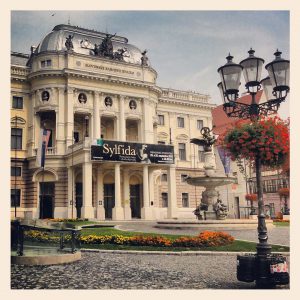 The Slovak National Gallery boasts outstanding Gothic works and more. Modern galleries also are sprinkled throughout the city. In fact, witty modern sculptures decorate the streets. The home of opera and ballet performances, the Neo-Renaissance Slovak National Theatre got its majestic appearance in 1885 and 1886. Going to a performance there is a thrill, and the unique chandelier that can create numerous light images is impressive.
The Slovak National Gallery boasts outstanding Gothic works and more. Modern galleries also are sprinkled throughout the city. In fact, witty modern sculptures decorate the streets. The home of opera and ballet performances, the Neo-Renaissance Slovak National Theatre got its majestic appearance in 1885 and 1886. Going to a performance there is a thrill, and the unique chandelier that can create numerous light images is impressive.
Saint Michael’s Gate and the New Bridge
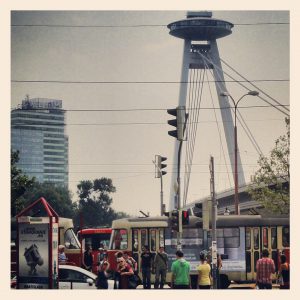 Saint Michael’s Gate dates from the beginning of the 14th century. Now a museum of weapons is located in its tower. The balcony offers stunning views of the Old Town. A much younger sight, dating from 1971, the New Bridge and Observation Deck rises 300 feet above the Danube River. Don’t forget to make lunch or dinner reservations for its UFO Restaurant which offers stunning views. Or just stop in for a coffee. A walk along the embankment of the Danube River is a must, too.
Saint Michael’s Gate dates from the beginning of the 14th century. Now a museum of weapons is located in its tower. The balcony offers stunning views of the Old Town. A much younger sight, dating from 1971, the New Bridge and Observation Deck rises 300 feet above the Danube River. Don’t forget to make lunch or dinner reservations for its UFO Restaurant which offers stunning views. Or just stop in for a coffee. A walk along the embankment of the Danube River is a must, too.
Devin Castle
Be sure to take a bus to the romantic ruins of Devin Castle, located at the confluence of the Morava and Danube Rivers. First mentioned in writing in 864, the castle played a significant role during the Roman Empire, during the 10th century as part of Great Moravia, and during the early years of Hungary’s existence. It was reduced to ruins by Napoleon in 1809. Now the ruins offer superb views and a museum featuring artifacts from the 12th to 19th centuries. Nature also thrives in Bratislava. There is a beautiful forest outside the city center. Parks also abound. Horsky Park is just one of the places that offer a respite from the hustle and bustle of city life.
Picturesque streets and a historical atmosphere
While the Old Town of Bratislava may be small, it offers a plethora of delights on its picturesque streets. Spend at least a day in Slovak’s capital to soak up the historical atmosphere and take in the Baroque palaces. The best time to visit is during spring or summer when the city is most lively with its outdoor cafes. Sip a cappuccino outside on one of its romantic streets. A look at your romantic surroundings is sure to impress.




